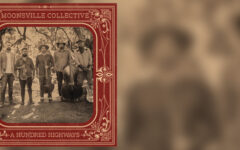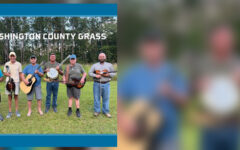
 The Spinney Brothers have become favorites of the traditional bluegrass crowd thanks to their unflagging love for bluegrass music’s past and a keen ear for what today’s listeners enjoy. Previous hits like I Wish That I Could Have Met Carter, My Music Comes from Bill, and Grandpa’s Way of Life prove that respect of tradition is alive and well. There’s plenty of the same on their latest album from Mountain Fever Records, Living the Dream, which features twelve tracks from several top bluegrass songwriters.
The Spinney Brothers have become favorites of the traditional bluegrass crowd thanks to their unflagging love for bluegrass music’s past and a keen ear for what today’s listeners enjoy. Previous hits like I Wish That I Could Have Met Carter, My Music Comes from Bill, and Grandpa’s Way of Life prove that respect of tradition is alive and well. There’s plenty of the same on their latest album from Mountain Fever Records, Living the Dream, which features twelve tracks from several top bluegrass songwriters.
The title track – which opens the album and was also the lead single – is one of the best here. Written by banjo-playing brother Rick Spinney and Ryan Roberts, it’s a smooth, wistful piece told from the perspective of a musician leaving his wife at home to go out on the road. It’s a little more plainspoken than some “life on the road” songs, confronting the reality of making sacrifices to pursue a dream. Lines like “While I’m living the dream, could use a little sleep right now” will likely hit home with many folks who have to travel for work. Rick’s banjo works well with fiddle from guest Ron Stewart. Brink Brinkman’s Letter to Myself is another thoughtful track with lyrics that will strike a chord with listeners. The song’s narrator imagines what he would tell his sixteen-year-old self, offering up poignant advice like spending more time with grandpa, and forgetting about the girl who caused his first heartbreak because a greater love is coming. The arrangement is sparse, with more of an acoustic country sound, but it fits the lyrics well.
When You and I Were Young finds the singer reminiscing on youth to a bouncy, mid-tempo melody with nice traditional mandolin from Gary Dalrymple. It was written by Gordon Wright, but has the flavor of a Tom T. and Dixie Hall song. Pocket Knife, another cut from Rick Spinney and Ryan Roberts, along with Timmy Saunlier, uses the title object as a symbol for all the lessons taught by a father to his son: “Sometimes the toughest love we learn is hard to understand, looking back my daddy carved a path to be a man.” Home, written by Daniel Salyer and Terry Foust, is a cheerful-sounding track that also looks back on youth, fittingly about growing up with a brother. Another highlight is the excellent Going Home to Tennessee, from the pen of bluegrass favorite Bill Castle. The Spinneys might be from Nova Scotia, but they sell the idea of getting to return to the redbuds and ringing banjos of Tennessee after thirty years on an assembly line. The song strolls along to a laidback melody, guided by Dalrymple’s mandolin and Rick and Allan’s smooth harmonies.
The Spinneys touch on coal mining with Randall Hylton’s Digging in the Ground. Like many bluegrass songs, it touches on a negative side of mining, but instead of focusing on mine disasters or broken-down bodies, the song speaks of how newfound wealth changed the local folks from “the finest people that you ever hoped to see” to selfish money-grubbers, and machinery “turned the hills and hollers upside down.” It’s a banjo-heavy number, with a dose of anger that isn’t often heard on Spinney Brothers albums. Banjo and strong G-runs also dominate Bitter Wind, a well-written song from Ray Edwards and Terry Foust. Allan Spinney tackles the lead vocals here with vigor, singing about a woman that did him wrong.
Though many of the songs here have a bit of a smooth, contemporary edge, two numbers stand out as strongly traditional. Lonely Lonely Bed, a pitiful number sung to a woman leaving her family, features some of the best banjo and mandolin picking on the album. Earl Taylor’s The Children are Crying tackles the same subject, with the singer hoping to appeal to the cheating wife with the image of her children crying and calling her name.
The concept of the power of memories runs strongly through this album. Whether they are singing about a father’s legacy, past mistakes, or young love, the Spinneys make sure listeners know that memories shape who we are and the choices we make. None of the songs here call out memories of bluegrass music itself as obviously as some of their past numbers, but Living the Dream is still a fine, well-rounded traditional bluegrass album that will surely be appreciated by many fans.







